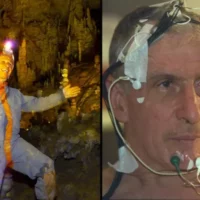Michel Siffre’s groundbreaking 1962 experiment delved deep into the uncharted territory of human chronobiology, providing profound insights into how isolation from natural time cues affects our biological and psychological rhythms. Venturing into the Scarasson cave in the Ligurian Alps, Siffre equipped with more than just a torch—his gear included scientific instruments to document his physical and mental responses over time—embarked on a journey that would challenge and expand our understanding of the human body’s internal clock.
This daring exploration not only tested his physical endurance but also his mental resilience, as he lived in total isolation for two months. Without access to sunlight or any external indicators of time, Siffre’s experience shed light on the adaptability of human circadian rhythms and their impact on our perception of time and psychological state. His findings have since influenced a wide range of fields, from sleep studies to the training protocols for astronauts, showcasing the intricate relationship between our environment and internal biological processes.

Exploring the Depths of Human Chronobiology
Michel Siffre’s 1962 expedition into the Scarasson cave in the Ligurian Alps was not merely a scientific endeavor; it was a plunge into the depths of human chronobiology. Armed with scientific instruments and fueled by curiosity, Siffre embarked on a journey that would challenge conventional notions of time and resilience. In the heart of the cave, over 130 meters below the earth’s surface, Siffre set up his base, surrounded by darkness and silence. With no natural light to guide him and no external cues to mark the passage of time, he entered a realm where the boundaries between day and night dissolved, and the rhythms of the external world ceased to exist.
In this subterranean world, Siffre lived according to his body’s internal clock, free from the constraints of societal schedules and the relentless ticking of a clock. His days were governed not by the rising and setting of the sun but by the ebb and flow of his own biological rhythms. He ate when hunger stirred within him, slept when fatigue enveloped him, and observed the subtle shifts in his physical and mental state with scientific precision. Far from the distractions of the modern world, he immersed himself in the study of his own being, seeking to unravel the mysteries of time and human existence.
As the days turned into weeks and the weeks into months, Siffre’s isolation became more than a scientific experiment; it became a profound exploration of the human spirit. Alone in the darkness, he confronted his fears, wrestled with his thoughts, and discovered the depths of his inner resilience. Each day brought new challenges and revelations, pushing him to the limits of his physical and mental endurance. Yet, amid the solitude and uncertainty, Siffre found a sense of purpose and clarity—a deepening understanding of himself and the world around him.
Unraveling the Mysteries of Time in Isolation
In the depths of the Scarasson cave, far removed from the rhythms of the outside world, Michel Siffre embarked on a journey to unravel the mysteries of time. His self-imposed isolation was not merely an exercise in endurance but a deliberate scientific inquiry into the nature of human chronobiology. Deprived of external time cues such as daylight and social schedules, Siffre’s existence became a study in the fundamental rhythms of human life. Each day, he observed the subtle shifts in his body’s internal clock, recording changes in sleep patterns, cognitive function, and emotional well-being.
Living in near-total darkness, Siffre’s perception of time underwent a profound transformation. Without the familiar markers of sunrise and sunset, days lost their meaning, blending seamlessly into one another. Time became fluid, subjective—a concept more felt than measured. Siffre’s experiments with time perception revealed startling insights into the plasticity of human consciousness, demonstrating how our experience of time is shaped by our environment and internal state. As the days stretched into weeks, he found himself living in a world untethered from the constraints of conventional timekeeping—a world where the passage of time was measured not in hours and minutes but in the rhythm of his own heartbeat.
Amidst the timeless void of the cave, Siffre’s research extended beyond the mere observation of his own physiological responses. He conducted meticulous experiments, measuring the fluctuations in his cognitive abilities and emotional states over time. Through tasks designed to assess memory, attention, and perception, he sought to understand how prolonged isolation impacted the intricate workings of the human mind. His findings not only shed light on the adaptability of the human brain but also raised profound questions about the nature of consciousness and the essence of human identity in the absence of external stimuli.

The Psychological Dimensions of Isolation
In the depths of solitude, Michel Siffre confronted not only the physical challenges of isolation but also the profound psychological dimensions of his experience. Cut off from the world above, he grappled with the stark reality of his own existence, facing moments of profound introspection and existential contemplation. The cave, once a sanctuary for scientific inquiry, became a crucible for the human psyche, testing the limits of Siffre’s resilience and mental fortitude. As the days turned into weeks and the weeks into months, he navigated the labyrinth of his own thoughts, confronting fears, doubts, and moments of profound loneliness.
One of the most striking psychological effects of isolation was the distortion of time perception. Stripped of external markers of time, Siffre’s sense of temporality became malleable, subject to the whims of his own consciousness. Days stretched into eternity, while moments of intense clarity flashed by in an instant. The relentless march of time, once a constant companion, became an elusive phantom, slipping through Siffre’s grasp with each passing moment. This temporal disorientation not only challenged his perception of reality but also raised fundamental questions about the nature of human consciousness and the construction of subjective experience.
Yet, amidst the solitude and uncertainty, Siffre discovered moments of profound insight and self-discovery. Alone with his thoughts, he delved into the depths of his own psyche, uncovering hidden reservoirs of strength and resilience. In the darkness of the cave, he found a renewed sense of purpose—a clarity of vision that transcended the confines of his physical surroundings. His isolation became a journey of self-exploration, a quest to understand the inner workings of the human mind and spirit. Through moments of solitude and introspection, Siffre forged a deeper connection with himself and the world around him, illuminating the profound resilience of the human spirit in the face of adversity.
Implications for Science and Beyond
Michel Siffre’s groundbreaking experiment in the Scarasson cave not only provided profound insights into human chronobiology and the psychological effects of isolation but also paved the way for a deeper understanding of human resilience and adaptability. His findings continue to resonate across a wide range of scientific disciplines, influencing everything from space exploration to the treatment of mental health disorders. By shedding light on the intricate interplay between environment, biology, and consciousness, Siffre’s work has challenged long-held assumptions about the nature of time and human existence.
One of the most significant implications of Siffre’s research lies in its relevance to space exploration. As humanity ventures further into the cosmos, the challenges of isolation and confinement become increasingly pertinent. Siffre’s experiments offer valuable insights into how astronauts may adapt to the extreme conditions of space travel, where traditional time cues are absent, and the boundaries between day and night blur. By understanding the psychological and physiological effects of isolation, space agencies can better prepare astronauts for the rigors of long-duration missions, ensuring their mental and physical well-being throughout the journey.
Moreover, Siffre’s work has broader implications for our understanding of human resilience in the face of adversity. By voluntarily subjecting himself to prolonged isolation, he demonstrated the capacity of the human spirit to endure and even thrive in the most challenging of circumstances. His experience serves as a testament to the resilience of the human mind and the transformative power of self-discovery. In a world where isolation and loneliness are increasingly prevalent, Siffre’s journey reminds us of the importance of connection, both with ourselves and with others, in navigating the complexities of the human experience.
Ultimately, Michel Siffre’s experiment in the Scarasson cave represents more than just a scientific curiosity—it is a profound exploration of the human condition. Through his courage and curiosity, Siffre peeled back the layers of time and consciousness, revealing the intricate tapestry of human existence beneath. His legacy continues to inspire scientists, explorers, and seekers of knowledge around the world, reminding us of the boundless potential of the human spirit to transcend the limitations of our earthly existence and reach for the stars.

Chronobiology: A New Frontier in Science
Michel Siffre’s pioneering experiment in the Scarasson cave opened the door to a new frontier in scientific inquiry: chronobiology. This interdisciplinary field explores the intricate rhythms that govern life on Earth, from the beating of our hearts to the cycles of the cosmos. Building on Siffre’s foundational work, researchers have delved deeper into the mechanisms underlying circadian rhythms, uncovering the molecular pathways that regulate our internal clocks. By understanding these biological rhythms, scientists aim to unlock new insights into human health and disease, paving the way for more effective treatments and interventions.
Chronobiology extends far beyond the confines of the laboratory, shaping our understanding of everything from sleep patterns to global climate patterns. By studying the rhythms of life on Earth, researchers can gain valuable insights into how organisms adapt to their environments and how ecosystems evolve over time. This holistic approach to science underscores the interconnectedness of all living things and highlights the importance of preserving the delicate balance of our planet’s natural rhythms.
As we continue to unravel the mysteries of chronobiology, we are reminded of the profound interconnectedness of all life on Earth. From the smallest microbe to the largest mammal, every organism dances to the rhythm of its own internal clock, synchronizing with the pulse of the planet. By embracing the principles of chronobiology, we can deepen our appreciation for the beauty and complexity of the natural world, and forge a path towards a more harmonious coexistence with the rhythms of life.
Practical Applications of Chronobiology in Daily Life
The insights from Michel Siffre’s groundbreaking research have transcended scientific boundaries, influencing various practical aspects of everyday life. Understanding the internal clocks that guide human physiology can lead to enhanced personal productivity, improved health, and better overall well-being. Here are some key applications of chronobiology that can be integrated into daily routines:
- Optimal Sleep Scheduling: Aligning sleep patterns with natural circadian rhythms can improve sleep quality and increase daytime alertness. For instance, going to bed and waking up at the same time each day can help reinforce the body’s sleep-wake cycle.
- Diet and Nutrition: Timing meals can affect the metabolism and overall digestive health. Eating larger meals earlier in the day when metabolism is higher and tapering off consumption as the day progresses can optimize nutrient uptake and weight management.
- Exercise Efficiency: Research suggests that the body’s physical performance varies throughout the day. Planning workouts during peak performance times, generally in the late afternoon when body temperature is highest, can enhance performance and reduce the risk of injury.
- Mental Health Management: Exposure to natural light, particularly in the morning, can boost mood and energy levels. This practice is beneficial for managing symptoms of depression and seasonal affective disorder (SAD).
- Medication Timing: Taking medications at specific times of the day can leverage natural physiological processes for maximum efficacy and minimal side effects, as explored in the field of chronotherapy.
These practical tips not only improve individual health and productivity but also underline the importance of respecting our biological rhythms in maintaining a balanced and healthy lifestyle.
Enhancing Daily Wellness with Chronobiology Insights
As we continue to uncover the nuances of chronobiology, it becomes increasingly clear how this science can directly enhance our daily lives. Here are some tailored tips and insights for integrating chronobiological principles into everyday wellness routines, making them not only informative but immediately applicable for our readers:
- Sleep Quality Improvement: Understanding your personal circadian rhythm can help you optimize your sleep schedule. Aim to maintain a consistent bedtime and waking time, even on weekends, to support your body’s internal clock.
- Eating Patterns for Better Health: Align your eating schedule with your body’s metabolism. Eating your largest meal in the morning or early afternoon, when metabolism is more active, can aid in digestion and weight management.
- Strategic Exercise: Plan your workouts according to your body’s energy levels. Typically, strength and flexibility are at their peak in the late afternoon, making it an ideal time for physical activities to maximize results and minimize injury.
- Mental Health Through Light Exposure: Regular exposure to natural light, especially in the morning, can significantly boost your mood and energy. This practice supports mental health and can be particularly effective for those managing depression or seasonal affective disorder.
- Timely Medication: Taking medications at the right time can leverage your body’s natural rhythms for better efficacy and reduced side effects. Discuss chronotherapy options with your healthcare provider to tailor your medication schedule to your circadian rhythm.
These practical applications of chronobiology not only help in enhancing personal health and wellness but also empower individuals to make informed decisions about their daily routines.



